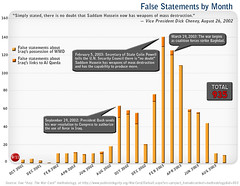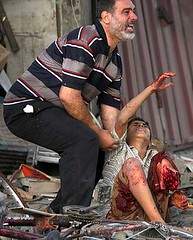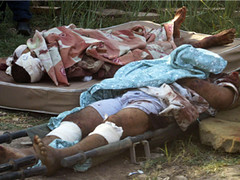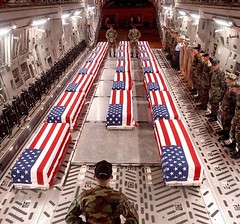The study is called "The War Card: Orchestrated Deception on the Path to War". This is the best kind of investigative journalism, work that methodically quantifies and proves. The liars can try to wriggle off the hook, but they have been skewered by facts.
All power tries to rewrite history. The more total the power, the more pervasive the rewrite. In our times the airbrushes appear with Orwellian speed, trying to tell us that what we know, really isn't so. That's why we need to constantly document the truth, and save it, cling to it, insist upon it.
From the overview:
President George W. Bush and seven of his administration's top officials, including Vice President Dick Cheney, National Security Adviser Condoleezza Rice, and Defense Secretary Donald Rumsfeld, made at least 935 false statements in the two years following September 11, 2001, about the national security threat posed by Saddam Hussein's Iraq. Nearly five years after the U.S. invasion of Iraq, an exhaustive examination of the record shows that the statements were part of an orchestrated campaign that effectively galvanized public opinion and, in the process, led the nation to war under decidedly false pretenses.
On at least 532 separate occasions (in speeches, briefings, interviews, testimony, and the like), Bush and these three key officials, along with Secretary of State Colin Powell, Deputy Defense Secretary Paul Wolfowitz, and White House press secretaries Ari Fleischer and Scott McClellan, stated unequivocally that Iraq had weapons of mass destruction (or was trying to produce or obtain them), links to Al Qaeda, or both. This concerted effort was the underpinning of the Bush administration's case for war.
It is now beyond dispute that Iraq did not possess any weapons of mass destruction or have meaningful ties to Al Qaeda. This was the conclusion of numerous bipartisan government investigations, including those by the Senate Select Committee on Intelligence (2004 and 2006), the 9/11 Commission, and the multinational Iraq Survey Group, whose "Duelfer Report" established that Saddam Hussein had terminated Iraq's nuclear program in 1991 and made little effort to restart it.
In short, the Bush administration led the nation to war on the basis of erroneous information that it methodically propagated and that culminated in military action against Iraq on March 19, 2003. Not surprisingly, the officials with the most opportunities to make speeches, grant media interviews, and otherwise frame the public debate also made the most false statements, according to this first-ever analysis of the entire body of prewar rhetoric.
President Bush, for example, made 232 false statements about weapons of mass destruction in Iraq and another 28 false statements about Iraq's links to Al Qaeda. Secretary of State Powell had the second-highest total in the two-year period, with 244 false statements about weapons of mass destruction in Iraq and 10 about Iraq's links to Al Qaeda. Rumsfeld and Fleischer each made 109 false statements, followed by Wolfowitz (with 85), Rice (with 56), Cheney (with 48), and McClellan (with 14).
The massive database at the heart of this project juxtaposes what President Bush and these seven top officials were saying for public consumption against what was known, or should have been known, on a day-to-day basis. This fully searchable database includes the public statements, drawn from both primary sources (such as official transcripts) and secondary sources (chiefly major news organizations) over the two years beginning on September 11, 2001. It also interlaces relevant information from more than 25 government reports, books, articles, speeches, and interviews.
. . . .
In addition to their patently false pronouncements, Bush and these seven top officials also made hundreds of other statements in the two years after 9/11 in which they implied that Iraq had weapons of mass destruction or links to Al Qaeda. Other administration higher-ups, joined by Pentagon officials and Republican leaders in Congress, also routinely sounded false war alarms in the Washington echo chamber.
The cumulative effect of these false statements — amplified by thousands of news stories and broadcasts — was massive, with the media coverage creating an almost impenetrable din for several critical months in the run-up to war. Some journalists — indeed, even some entire news organizations — have since acknowledged that their coverage during those prewar months was far too deferential and uncritical. These mea culpas notwithstanding, much of the wall-to-wall media coverage provided additional, "independent" validation of the Bush administration's false statements about Iraq.
It concludes:
Bush and the top officials of his administration have so far largely avoided the harsh, sustained glare of formal scrutiny about their personal responsibility for the litany of repeated, false statements in the run-up to the war in Iraq. There has been no congressional investigation, for example, into what exactly was going on inside the Bush White House in that period. Congressional oversight has focused almost entirely on the quality of the U.S. government's pre-war intelligence — not the judgment, public statements, or public accountability of its highest officials. And, of course, only four of the officials — Powell, Rice, Rumsfeld, and Wolfowitz — have testified before Congress about Iraq.
Short of such review, this project provides a heretofore unavailable framework for examining how the U.S. war in Iraq came to pass. Clearly, it calls into question the repeated assertions of Bush administration officials that they were the unwitting victims of bad intelligence.
Above all, the 935 false statements painstakingly presented here finally help to answer two all-too-familiar questions as they apply to Bush and his top advisers: What did they know, and when did they know it?
There are links to each person in the junta who spread the propaganda, the principal lies that they told, and a correlation between those lies and public opinion. Because, as the report mentions, these liars had a lot of help, as their lies were "amplified by thousands of news stories and broadcasts".
George W. Bush, Richard Cheney, Colin Powell, Condoleezza Rice, Donald Rumsfeld, Paul Wolfowitz: mass murderers. Ari Fleischer and Scott McClellan: their paid assassins.
To date, there have been almost 90,000 documented Iraqi civilian deaths, and almost 4,238 combined "coalition" deaths (3,931 US).
The formula:
Incidentally, that last photo was made public by an employee of a Pentagon contractor, who snapped the photo in Germany and released it to the Seattle Times. She and her husband were both subsequently fired.
Lies, and the power to make the truth go away.







No comments:
Post a Comment